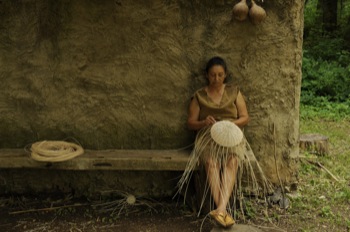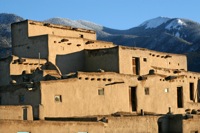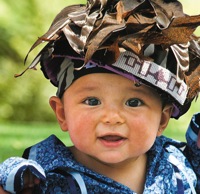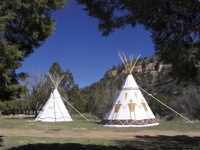 Photo courtesy Oklahoma Tourism and Recreation Department
Photo courtesy Oklahoma Tourism and Recreation Department
When you touch it, taste it and experience it for yourself, Native American culture comes alive in a whole new way.
In much of the United States, we do not encounter living Native American culture and heritage very often. But there are places across the country, from the Southwest to the Northeast and dozens of points in between, where Indian culture still thrives.
For many tribes, tourism has become a powerful economic engine, and groups interested in Native American history will find no shortage of opportunities to experience their fascinating cultures in a variety of ways. From hands-on art classes taught by native masters to traditional Indian meals and tours through ancestral lands, these experiences will bring the rich heritage and colorful traditions of America’s native people into new light.
Cherokee Nation
Oklahoma
Although the Cherokee Nation originally lived in the eastern United States, relocation and the Trail of Tears brought much of the Cherokee population to Oklahoma. Today, Cherokee Nation Cultural Tourism offers a variety of tours to introduce visitors to the Cherokee people and their influence on the area.
“Our tourism program was established in 2007 to promote and preserve Cherokee heritage and culture,” said senior project manager Travis Owens. “We’re offering four different tour packages that really immerse people in Cherokee culture.”
The Cherokee History Tour takes visitors to the town of Tahlequah, the seat of Cherokee government, where they’ll see the national supreme court and national penitentiary. The tour also includes a visit to Adam’s Corner Rural Village, a living-history site that shows what life was like in the 1800s for Cherokee people in Oklahoma.
The three other tours introduce visitors to additional elements of Cherokee history and culture, including Cherokee involvement in the Civil War and the life of Will Rogers, an Oklahoman of Cherokee descent who became one of America’s most popular entertainers in the 20th century.
On any of the four tours, groups will have opportunities to experience Cherokee culture and customs firsthand.
“All of our standard tour packages come with a traditional meal,” Owens said. “Groups get to see foods like hominy, corn squash and hog meat. In addition to our traditional meals, people can customize things, like making pottery with our artists and craftspeople.
“They are our national treasures, who have made tremendous contributions to Cherokee art, and visitors can not only meet them but learn from them.”
www.cherokeetourismok.com
Billie Swamp Safari
Clewiston, Fla.
In the Florida Everglades, the Seminole people have made their home amidst the wildlife and wetlands for generations. Today, visitors can get to know Seminole traditions and the environment the Seminoles call home during a variety of experiences available at Billie Swamp Safari.
 |
| Courtesy Billie Swamp Safari |
“The tribal members are very private, and people would drive out to the Everglades to see a Seminole,” said Cindy Malin, director of marketing for Billie Swamp Safari. “So to keep the general public from driving up to people’s front doors, they created Billie Swamp Safari so people could actually have an experience and get a taste for the Seminole culture of the Everglades.”
Groups can take ecotours of the wetlands in swamp buggies, motorized vehicles with large wheels that can seat up to 30 people. During these open-air excursions, participants often see animals such as wild hogs, deer, bison, ostriches, alligators and wild horses. Occasionally, a lucky tour group will spot a panther or a bear.
Another tour option is the airboat ride, which takes passengers gliding across the top of the water and the saw grass. These tours usually highlight aquatic creatures, including fish, turtles, alligators and birds.
For a more immersive experience, the organization offers overnight stays to groups.
“You can spend the night in a chickee, which is a thatched-roof dwelling,” Malin said. “That’s how the Seminoles used to live in the Everglades, and some still do. And if you stay for the night, we do campfire storytelling. A lot of times they go into the old myths and stories that have been passed down through the generations by tribal members.”
Taos Pueblo
New Mexico
In Taos, N.M., an area popular for skiing and Southwestern art, visitors can encounter one of the oldest Native American villages in the country.
 |
| Courtesy Taos Pueblo |
“Our history and oral tradition dictate a span of occupancy for over a millennium,” said Marcie Winters, tourism representative for Taos Pueblo. “Many historians and archaeologists say the pueblo has been around since at least 1350 A.D. We’re basically a traditional people that is surrounded by today’s modern society, and our will to survive is reflected today in our language and customs.”
The most notable aspect of the pueblo is its historic area, which has been declared a World Heritage Site. The historic village comprises a cluster of multistory adobe houses built in the traditional style. These structures are centuries old and once were the common dwelling for all of the Pueblo people.
About 100 people still live and work in the historic area, and tours offer groups a fascinating look at Pueblo life and culture.
“The pueblo is one of the best examples of adobe architecture in New Mexico,” Winters said. “We have guided tours, and we encourage the tours, because it gives you the chance to engage with one of our tribal people. It’s more personal.”
During the tour, visitors will see some of the traditional homes, which still have no electricity or running water, as well as important religious and ceremonial sites. There’s also time to visit the galleries and artists’ workshops in the village or to sample some typical Pueblo food.
Groups that make arrangements can have special experiential experiences.
“They can have storytelling or some kind of special dance for a group,” Winters said. “Sometimes, they can see the women baking bread in the outdoor ovens or see someone making a drum or a piece of jewelry.”
Seneca Nation
New York
In western New York, about 7,500 members of the Seneca Nation live in a number of communities and preserve their history and customs through cultural events, dance, music, art and food. The Seneca were one of five original members of the Iroquois Confederacy.
 |
| Courtesy Seneca Nation |
The Seneca-Iroquois National Museum in Salamanca is a great place to get an introduction to Seneca history. One popular facet of the museum is a re-creation of a Seneca longhouse.
“It gives people a sense of what it was like to live in a longhouse,” said museum marketing manager Sue Grey. “There could be anywhere from 20 to 30 families living in one of these structures, but they would all be from the same clan. It shows the two compartments a family would have — a place to sleep and the upper compartment where they would put their clothes or cooking utensils.”
The museum will host a series of special cultural workshops this May, including classes on beadwork and cornhusk doll making.
Annual events also give groups an opportunity to experience modern Seneca culture. The Seneca Allegany Veteran’s Pow Wow takes place in July, and a Fall Festival every September in Irving features a parade, an art show, traditional dancing and sporting events.
Lac du Flambeau
Wisconsin
The state of Wisconsin is full of pockets of native people, and there are a variety of communities and reservations where visitors can learn about the local native people and their culture. In Lac du Flambeau, the Ojibwa people, also known as Chippewa, live among 260 lakes and 12,000 acres of wetlands.
About half of the members of this 3,000-person community are Native Americans. Visitors can learn about their life at the Ojibwa Museum and Cultural Center.
“They offer a collection of history, workshops and interactive exhibits,” said Cathy Benton, executive director of the Lac du Flambeau Chamber of Commerce. “They have arts-and-crafts workshops where they’ll help you make a dream catcher or teach you beading or woodcarving. The instructors are all Native American artists.”
There are more hands-on experiences at Chain Three, a shop that offers beading and crafts classes. And at the Native Woodland Art Gallery, visitors can watch artists and woodcarvers work and then browse the gallery to find a piece of artwork to take home.
During the summer, food vendors downtown offer traditional Ojibwa foods, such as fry bread and wild rice dishes.
Another popular Native American experience is Woswagoning.
“It’s a walking tour through a traditional Indian village,” Benton said. “There are stations that show different things like fish traps, birch bark baskets, bows and arrows, spears and hides. And you’re walking on a rustic trail through the woods to all of those stations.”
www.lacduflambeauchamber.com
Village of Many Nations
Kanab, Utah
In addition to ATV tours, horseback riding and beautiful scenery, guests at Cave Lake Canyon Resort can explore the cultures of various Native American groups at the Village of Many Nations.
 |
| Courtesy Village of Many Nations |
This cultural experience is the project of husband and wife Art and Carol Letkey, who for seven years have operated in the Zion National Park area of Utah. Today, their village is set up on the grounds of the resort and is open to visitors from anywhere.
“When people come to us, they sleep in teepees or hogans and do craft classes,” Art Letkey said. “We have people that will share the cultures of the particular tribes. We also do craft classes — people can sit down and make their own dream catchers. We also have tomahawk throws and bow-and-arrow shooting, with targets set up for them.”
The Village of Many Nations includes dozens of structures that represent dwellings used by a variety of native groups from around the Southwest. Guests will see about 30 teepees, as well as seven hogans, which are earthen Navajo lodges, and a longhouse, which is in the process of being built.
Groups can visit the different structures and see arts and crafts practiced there, or arrange a traditional Native American meal and accompanying show complete with flute players, native dancers and storytellers.
“We didn’t go to the tribes themselves, but we went to individuals from different tribal cultures that know their heritage and want to share it,” Letkey said. “And they don’t mind sitting next to each other, telling their stories and laughing together.
“This place is here so that they can share their culture and tell their stories, not just the white man’s version.”
www.villageofmanynations.com












